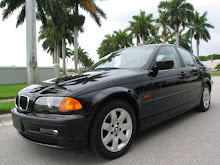
For as long as enthusiasts can remember BMW has always geared their engine's performance towards the raw power delivered to the wheels. They never fooled around with forced induction (turbochargers) as the Japanese had been doing for nearly 3 decades. As a matter of fact, it was not until the 335i broke out onto the scene back in 2007, that BMW experimented with turbocharging their vehicles. BMW recognizes that by downsizing your engine and then equipping it with a turbocharger will actually help to pump out a few more mpgs (miles per gallon). With today's economy and the current "oil crisis," people are becoming more aware of how fuel efficient their vehicles actually are. In contrast to the previous statement, this is NOT to say that BMW plans on sacrificing performance for more mpgs. Thank God!
The "twin-turbocharged" 335i uses BMW's famed inline six but is given a bit of extra pep by two baby turbos. Before moving on, let me clear the air when it comes to using the terms twin or bi-turbo. To put it simply, twin-turbos act independently of one another and bi-turbos fire together. Now with that said, the twin-turbo 335i uses one of it's two turbos right around the 1500 rpm mark while the second turbo does not kick in until around 4000 rpms. It is not that BMW is just trying to "one-up" the single turbo competition; they actually have a very important reason for using two turbos. As any gearhead would know, many single turbo cars suffer from "turbo-lag." This happens when the, usually underpowered, engine doesn't receive it's turbo boost until the higher rpms. Unfortunately this makes the powerband unreachable until you hit anywhere between 4000 and 6000 rpms (dependent upon the vehicle). Turbo-lag is nonexistent in the 335i's rev range and the powerband kicks in from the moment you step on the peddle to when you hit redline.
The two newest additions to BMW's turbo family are the X5 M and the X6 M. Both of these vehicles are powered by a twin-turbo 4.4 lt. V8 producing upwards of 555bhp. Some of you may recognize the 4.4 lt. V8 to be that of the since departed X5 4.4i which made its debut in 2000 and ran until its departure in 2006. Since many were taken back by the overall performance of 4.4 when it was in the previous X5, BMW decided to build off of that same platform when it came time to design the X5 M and X6 M's powerhouse. The new all wheel drive M SUVs use the same turbo technology as the 335i which is sure to produce monstrous performance on and off the track! In addition to these two turbo beasts, there has been word that BMW has decided to drop the 10 cylinder in the current M5 and turbocharge a V8 for the 2012 model. Figures are scarce to come by but it is said that the car should be pushing an upwards of 600bhp, as if 505 was not enough...



yay 2001 X5 4.4
ReplyDelete